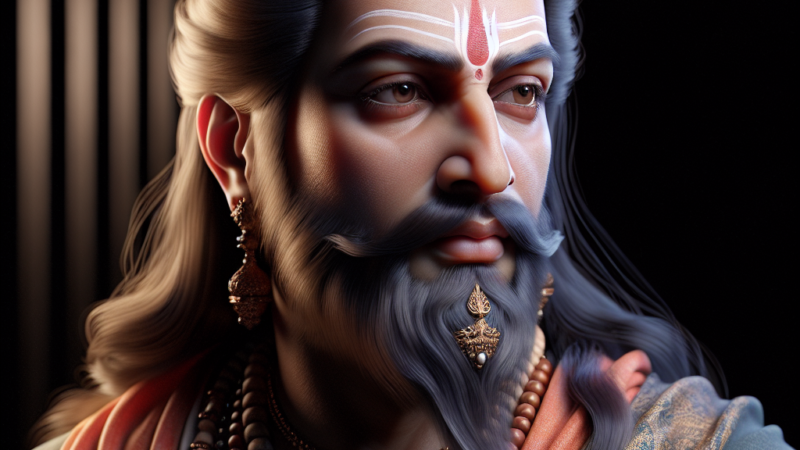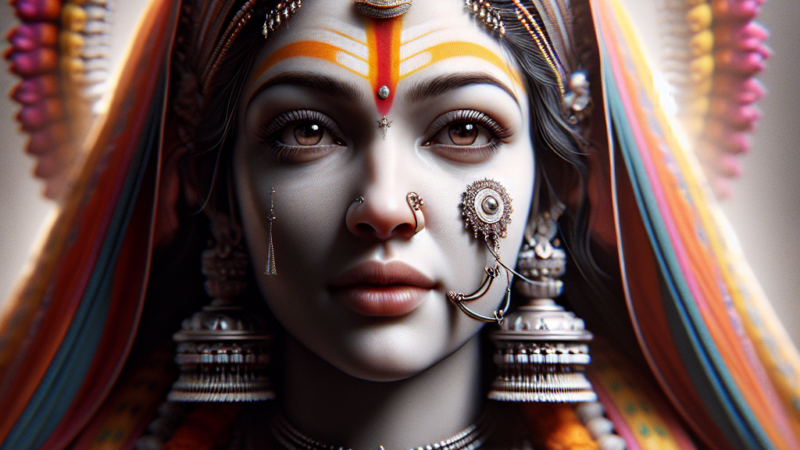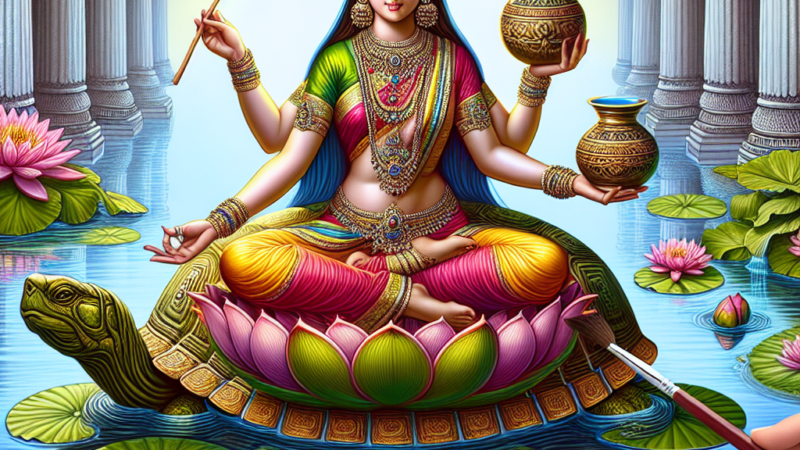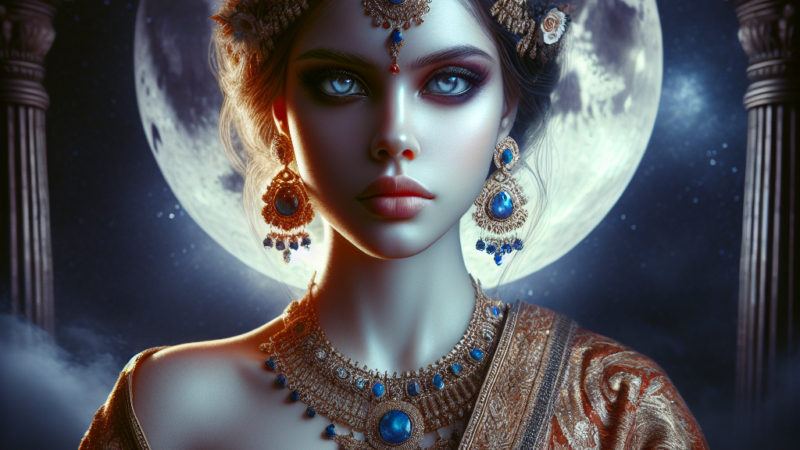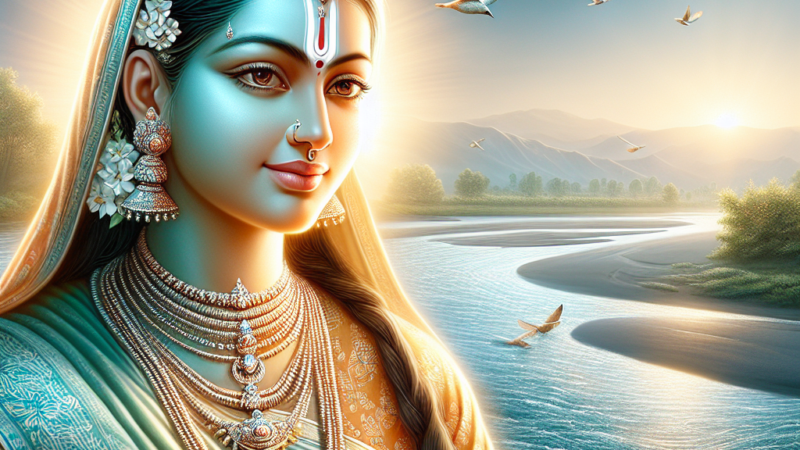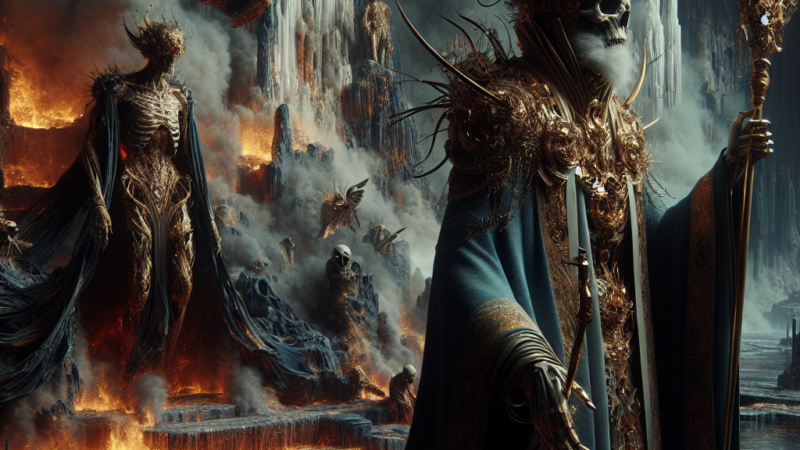Veerabhadra: The Fierce Warrior Form of Shiva
Introduction

Veerabhadra, a fierce and formidable warrior form of Lord Shiva, holds a significant place in Hindu mythology and religious practices. Known for his wrath and valor, Veerabhadra was created by Shiva to avenge the insult to his consort, Sati. This deity embodies the destructive and protective aspects of Shiva, showcasing the duality of creation and destruction inherent in the universe. Veerabhadra’s tales are deeply interwoven with the themes of loyalty, justice, and cosmic balance, making him an essential figure in Hinduism.
Veerabhadra’s importance in Hinduism is multifaceted. He is revered as a protector of dharma (cosmic law and order) and a fierce enforcer of divine justice. His stories and iconography serve as powerful reminders of the consequences of disrespecting divine principles and the strength of divine retribution. Veerabhadra’s role extends beyond mythology into cultural practices, festivals, and rituals, reflecting his enduring influence in Hindu worship and tradition.
Etymology and Meaning
Origin of the Name Veerabhadra
The name “Veerabhadra” is derived from two Sanskrit words: “Veera,” meaning “heroic” or “brave,” and “Bhadra,” meaning “auspicious” or “blessed.” Together, the name signifies a heroic and auspicious warrior, embodying both valor and divine favor.
Variations of the Name
Veerabhadra is known by various names and titles across different texts and regions. In some scriptures, he is referred to as “Veerabhadra Swamy” or simply “Veera.” Regional variations include “Veerabhadra Ayyappa” in South India, where he is often associated with local deities and traditions.
Symbolic Meaning
The name Veerabhadra symbolizes the dual nature of Shiva as both a creator and destroyer. It reflects the idea that divine intervention can be both protective and punitive, depending on the circumstances. Veerabhadra’s name also underscores the importance of bravery and righteousness in upholding cosmic order.
Mythological Origins and Stories
Major Myths and Stories
The most prominent myth associated with Veerabhadra is his creation by Shiva to avenge the death of Sati. According to the legend, Sati, Shiva’s consort, immolated herself in the sacrificial fire after her father, Daksha, insulted Shiva by not inviting him to a grand yajna (sacrificial ritual). Enraged by Sati’s death, Shiva tore a lock of his hair and threw it to the ground, from which emerged Veerabhadra, a fearsome warrior with a mission to destroy Daksha’s sacrificial ceremony and punish those who disrespected Shiva.
Role in Major Hindu Epics
While Veerabhadra’s primary story is not directly part of the major Hindu epics like the Mahabharata and Ramayana, his influence and presence are felt in various Puranic texts and regional adaptations of these epics. His story is often recounted in the Shiva Purana and other texts that explore the various forms and manifestations of Shiva.
Other Significant Tales
In addition to the primary myth, Veerabhadra is featured in various regional folklore and temple legends. In some stories, he is depicted as a guardian deity who protects devotees from evil forces and ensures the sanctity of sacred spaces. These tales highlight his role as a protector and enforcer of divine will.
Iconography and Symbols
Depiction in Art, Statues, and Temples
Veerabhadra is typically depicted as a fierce warrior with a formidable appearance. He is often shown with multiple arms, each holding a weapon such as a sword, trident, or mace. His eyes are depicted as fiery and intense, symbolizing his wrath and determination. In some depictions, he is accompanied by his consort, Bhadrakali, who shares his fierce attributes.
Common Symbols
Several symbols are commonly associated with Veerabhadra:
- Weapons: Veerabhadra is often depicted with a variety of weapons, including a sword, trident, and bow. These symbolize his martial prowess and readiness to combat evil.
- Third Eye: Like Shiva, Veerabhadra is sometimes shown with a third eye on his forehead, representing his divine vision and destructive power.
- Serpents: Serpents are often depicted around his neck and arms, symbolizing his connection to Shiva and his control over primal forces.
- Vahana (Mount): Veerabhadra is sometimes shown riding a bull, similar to Shiva’s mount, Nandi, symbolizing strength and steadfastness.
Meaning and Significance of Symbols
The symbols associated with Veerabhadra emphasize his role as a divine warrior and protector. The weapons signify his readiness to defend dharma, while the third eye and serpents highlight his connection to Shiva’s destructive and transformative powers. The bull as his mount underscores his strength and unwavering commitment to justice.
Worship and Rituals
Festivals Dedicated to Veerabhadra
Veerabhadra is honored in various festivals across India, particularly in regions where his worship is prominent. One such festival is “Veerabhadra Jayanthi,” celebrated with great fervor in South India. During this festival, devotees perform special rituals, offer prayers, and participate in processions to honor the deity.
Common Rituals and Practices
Worship of Veerabhadra often involves rituals that emphasize his warrior aspect. Devotees may perform abhishekam (ritual bathing) of his idol with water, milk, and other sacred substances. Offerings of flowers, fruits, and incense are common, along with the chanting of specific mantras dedicated to Veerabhadra. In some regions, martial arts demonstrations and dances are performed as part of the worship, symbolizing the deity’s valor and strength.
Sacred Texts and Mantras
Several sacred texts and mantras are associated with Veerabhadra. The “Veerabhadra Ashtakam” is a popular hymn that extols his virtues and seeks his protection. Additionally, verses from the Shiva Purana and other Puranic texts that recount his story are often recited during worship. The mantra “Om Veerabhadraya Namah” is commonly chanted by devotees to invoke his blessings.
Temples and Sacred Sites
Major Temples Dedicated to Veerabhadra
There are several temples dedicated to Veerabhadra across India, each with its unique significance:
- Veerabhadra Temple, Lepakshi: Located in Andhra Pradesh, this temple is renowned for its exquisite architecture and intricate carvings. It is one of the most famous temples dedicated to Veerabhadra and attracts numerous pilgrims and tourists.
- Veerabhadra Swamy Temple, Warangal: Situated in Telangana, this temple is another important site of worship for Veerabhadra. It is known for its historical significance and vibrant festivals.
- Veerabhadra Temple, Bangalore: Located in Karnataka, this temple is a popular pilgrimage site, especially during the annual Veerabhadra Jayanthi festival.
Significance of These Temples
The temples dedicated to Veerabhadra serve as important centers of worship and cultural heritage. They are not only places of spiritual significance but also repositories of art, architecture, and history. Pilgrims visit these temples to seek Veerabhadra’s blessings for protection, courage, and justice.
Annual Pilgrimages and Religious Events
Annual pilgrimages and religious events at these temples draw large crowds of devotees. The Veerabhadra Jayanthi festival is a major event, marked by elaborate rituals, processions, and cultural performances. These gatherings foster a sense of community and reinforce the cultural and religious importance of Veerabhadra.
Regional Variations and Cultural Impact
Regional Worship Practices
Veerabhadra’s worship varies across different regions of India, reflecting local traditions and cultural influences. In South India, particularly in Andhra Pradesh, Karnataka, and Tamil Nadu, his worship is more prominent, with dedicated temples and festivals. In these regions, Veerabhadra is often associated with local deities and folk traditions, blending seamlessly into the regional religious landscape.
Influence in Regional Folklore and Festivals
Veerabhadra’s influence extends into regional folklore and festivals. In some areas, he is revered as a village guardian deity, protecting the community from evil forces and ensuring prosperity. Folk performances, such as the Veerabhadra dance in Karnataka, depict his heroic exploits and are integral to local festivals and celebrations.
Cultural Impact in Literature, Art, and Performing Arts
Veerabhadra’s stories and attributes have inspired various forms of cultural expression. In literature, his tales are recounted in regional epics, poems, and devotional songs. In art, his fierce form is depicted in paintings, sculptures, and temple carvings. Performing arts, such as dance and theater, often portray his mythological battles and divine interventions, highlighting his enduring cultural impact.
Related Deities and Associations
Connections with Other Deities
Veerabhadra is closely associated with other deities in the Hindu pantheon, particularly Shiva and his consort, Parvati (in her form as Sati or Bhadrakali). He is considered an extension of Shiva’s power and wrath, embodying the destructive aspect of the divine. Veerabhadra’s creation and actions are directly linked to the events surrounding Sati’s self-immolation and Shiva’s subsequent rage.
Family Relationships
In Hindu mythology, Veerabhadra is often depicted as a loyal servant or manifestation of Shiva. He is sometimes accompanied by Bhadrakali, a fierce form of Parvati, who shares his attributes of wrath and protection. Together, they represent the combined power of Shiva and Parvati in their warrior forms.
Role in the Broader Hindu Pantheon
Within the broader Hindu pantheon, Veerabhadra serves as a reminder of the consequences of disrespecting divine principles and the importance of upholding dharma. His role as a fierce enforcer of divine justice complements the more benevolent aspects of other deities, highlighting the balance between creation and destruction in the cosmic order.
Modern Relevance and Popularity
Contemporary Hindu Practice
In contemporary Hindu practice, Veerabhadra continues to be revered as a powerful protector and enforcer of justice. His worship is particularly prominent in regions with dedicated temples and festivals. Devotees seek his blessings for courage, protection, and the resolution of conflicts, reflecting his enduring relevance in modern times.
Influence in Modern Media and Popular Culture
Veerabhadra’s influence extends into modern media and popular culture. His stories and attributes are depicted in television series, movies, and comic books, bringing his mythological exploits to a wider audience. These portrayals often emphasize his heroic qualities and divine wrath, resonating with contemporary themes of justice and valor.
Ongoing Traditions and Devoted Communities
Several communities and traditions continue to be devoted to Veerabhadra, maintaining rituals and practices that have been passed down through generations. These communities often organize annual festivals, processions, and cultural events to honor the deity, ensuring that his legacy remains vibrant and relevant.
Conclusion
Veerabhadra, the fierce warrior form of Shiva, embodies the dual aspects of destruction and protection inherent in the divine. His mythological origins, iconography, and worship practices highlight his significance as an enforcer of divine justice and a protector of dharma. Through temples, festivals, and cultural expressions, Veerabhadra’s legacy continues to inspire and resonate with devotees across India and beyond.
In summary, Veerabhadra’s continued importance in Hinduism and global culture underscores the enduring relevance of his attributes and stories. As a symbol of divine wrath and protection, he serves as a powerful reminder of the consequences of disrespecting cosmic principles and the strength of divine intervention. For followers, Veerabhadra remains a source of courage, justice, and unwavering devotion.
Frequently Asked Questions (FAQs)
Who is Veerabhadra?
Veerabhadra is a fierce warrior form of Lord Shiva, created to avenge the death of Shiva’s consort, Sati. He embodies Shiva’s wrath and serves as an enforcer of divine justice.
What is the significance of Veerabhadra in Hinduism?
Veerabhadra is significant in Hinduism as a protector of dharma and a symbol of divine retribution. His stories and worship practices emphasize the importance of upholding cosmic order and respecting divine principles.
How is Veerabhadra depicted in art and iconography?
Veerabhadra is typically depicted as a fierce warrior with multiple arms holding weapons. He is often shown with fiery eyes, a third eye on his forehead, and serpents around his neck and arms. These symbols highlight his martial prowess and divine power.
What are some major temples dedicated to Veerabhadra?
Major temples dedicated to Veerabhadra include the Veerabhadra Temple in Lepakshi, Andhra Pradesh; the Veerabhadra Swamy Temple in Warangal, Telangana; and the Veerabhadra Temple in Bangalore, Karnataka. These temples are important centers of worship and cultural heritage.
How is Veerabhadra worshipped in different regions of India?
Veerabhadra’s worship varies across regions, with South India having a more prominent tradition of dedicated temples and festivals. Regional practices often blend local traditions and folklore with the worship of Veerabhadra, reflecting his integration into the regional religious landscape.
What are some common rituals and festivals associated with Veerabhadra?
Common rituals include abhishekam (ritual bathing) of his idol, offerings of flowers and incense, and chanting of specific mantras. The Veerabhadra Jayanthi festival is a major event celebrated with processions, cultural performances, and special rituals.
References and Further Reading
Shiva Purana
The Shiva Purana is a key scripture that recounts the stories and attributes of Lord Shiva, including the creation and exploits of Veerabhadra.
Skanda Purana
The Skanda Purana contains various legends and tales related to Shiva and his manifestations, including Veerabhadra.
Veerabhadra Ashtakam
The Veerabhadra Ashtakam is a popular hymn dedicated to Veerabhadra, extolling his virtues and seeking his protection.
Books on Hindu Mythology
Several books on Hindu mythology provide detailed accounts of Veerabhadra’s stories and significance. Notable titles include “Myth = Mithya: A Handbook of Hindu Mythology” by Devdutt Pattanaik and “Hindu Myths: A Sourcebook Translated from the Sanskrit” by Wendy Doniger.
Academic Articles and Journals
Academic articles and journals on Hindu studies often explore the cultural and religious significance of Veerabhadra. Journals such as the “Journal of Hindu Studies” and “International Journal of Hindu Studies” are valuable resources for further research.
We strive to present the teachings of Ramana Maharshi and the traditions of Sanatana Dharma with respect and accuracy. Terms like "mythology" are used for ease of understanding and are not meant to diminish the significance of sacred texts.
